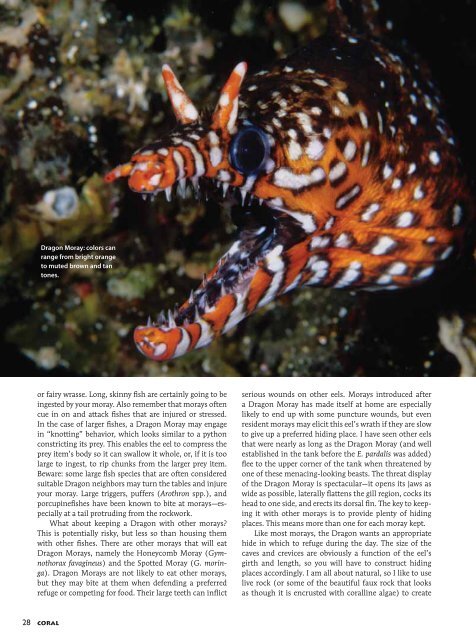Create successful ePaper yourself
Turn your PDF publications into a flip-book with our unique Google optimized e-Paper software.
Dragon Moray: colors can<br />
range from bright orange<br />
to muted brown and tan<br />
tones.<br />
or fairy wrasse. Long, skinny fish are certainly going to be<br />
ingested by your moray. Also remember that morays often<br />
cue in on and attack fishes that are injured or stressed.<br />
In the case of larger fishes, a Dragon Moray may engage<br />
in “knotting” behavior, which looks similar to a python<br />
constricting its prey. This enables the eel to compress the<br />
prey item’s body so it can swallow it whole, or, if it is too<br />
large to ingest, to rip chunks from the larger prey item.<br />
Beware: some large fish species that are often considered<br />
suitable Dragon neighbors may turn the tables and injure<br />
your moray. Large triggers, puffers (Arothron spp.), and<br />
porcupinefishes have been known to bite at morays—especially<br />
at a tail protruding from the rockwork.<br />
What about keeping a Dragon with other morays?<br />
This is potentially risky, but less so than housing them<br />
with other fishes. There are other morays that will eat<br />
Dragon Morays, namely the Honeycomb Moray (Gymnothorax<br />
favagineus) and the Spotted Moray (G. moringa).<br />
Dragon Morays are not likely to eat other morays,<br />
but they may bite at them when defending a preferred<br />
refuge or competing for food. Their large teeth can inflict<br />
serious wounds on other eels. Morays introduced after<br />
a Dragon Moray has made itself at home are especially<br />
likely to end up with some puncture wounds, but even<br />
resident morays may elicit this eel’s wrath if they are slow<br />
to give up a preferred hiding place. I have seen other eels<br />
that were nearly as long as the Dragon Moray (and well<br />
established in the tank before the E. pardalis was added)<br />
flee to the upper corner of the tank when threatened by<br />
one of these menacing-looking beasts. The threat display<br />
of the Dragon Moray is spectacular—it opens its jaws as<br />
wide as possible, laterally flattens the gill region, cocks its<br />
head to one side, and erects its dorsal fin. The key to keeping<br />
it with other morays is to provide plenty of hiding<br />
places. This means more than one for each moray kept.<br />
Like most morays, the Dragon wants an appropriate<br />
hide in which to refuge during the day. The size of the<br />
caves and crevices are obviously a function of the eel’s<br />
girth and length, so you will have to construct hiding<br />
places accordingly. I am all about natural, so I like to use<br />
live rock (or some of the beautiful faux rock that looks<br />
as though it is encrusted with coralline algae) to create<br />
28 CORAL

















